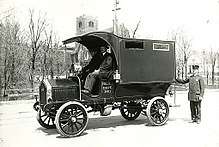Police van
A police van (also known as a paddy wagon, patrol wagon, Black Maria or police carrier) is a type of vehicle operated by police forces. Police vans are usually employed for the transportation of prisoners inside a specially adapted cell in the vehicle, or for the rapid transportation of a number of officers to an incident.
History
Early police vans were in the form of horse-drawn carriages,[1] with the carriage being in the form of a secure prison cell. Frank Fowler Loomis designed and built the world's first motorized police patrol wagon ("paddy wagon").[2] In the modern age, motorised police vans replaced the older Black Maria and paddy wagon types as they were usually crudely adapted for accommodation of prisoners.
The need for a secure police van was realised when prisoners who were resisting arrest needed to be transported. The concern was that if transported in a conventional patrol car, the prisoner might attack the officers during the journey.
To combat this, police vans were designed with a fixed steel cage in the rear of the vehicle effectively separating the prisoner from the officers.
Etymology
Paddy Wagon


_SR_4-door_utility%2C_Western_Australia_Police_(2018-08-06).jpg)

The precise origin of the term is uncertain and disputed, though its use dates back to the 1800s.[3]
There are three theories as to how the term originated.
- In the United States, "Paddy" was a common Irish shortening of Padraig, (Patrick in English), which was most often used in the 19th century as an ethnic slur to refer to Irish people.[4] Irishmen made up a large percentage of the officers of early police forces in many American cities. Thus, this theory suggests that the concentration of Irish in the police forces led to the term "paddy wagon" being used to describe the vehicles driven by police. The theory is weak because "paddy" was never a term used for police in general, and the majority of Irish people were not police.
- The most common understanding in the United Kingdom also stems from the belief that the most common occupants of the vans were Irish, though they were not driving, they were the arrested passengers. This comes from several perspectives: a) prejudice by English people that the Irish immigrants were largely common criminals, b) from the legendary stories of their fighting spirit and the fact that when arrested they were less likely to "go quietly" than other nationalities, requiring the use of the van rather than a carriage, and c) that the Irish liked to drink so much that drunken brawling would often ensue and thus the police van would be called to take them away into custody.
- A third theory holds that "paddy wagon" was originally a nickname for "patrol wagon." In the same manner police cars are called patrol cars today.[5]
Black Maria
These vehicles were usually painted black or a very dark blue. In the United Kingdom, Ireland, New Zealand and the United States, a police wagon was also sometimes called a Black Maria (/məˈraɪə/ mə-RY-ə). The origin of this term is equally uncertain. The name Black Maria is common for race horses beginning with an 1832 appearance in Niles Weekly Register (Oct. 10) and then again in Colburn's New Monthly Magazine and Humorist (1841).[6] The OED lists the first usage as the Boston Evening Traveller from 1847 which mentions them as a new type of wagon. An example from Philadelphia was published in 1852.[7] Brewer's Dictionary of Phrase and Fable suggests the name came from Maria Lee, a large and fearsome black keeper of a sailors' boarding house whom the police would call on for help with difficult prisoners. The French detective novel Monsieur Lecoq, published in 1868 by Émile Gaboriau, uses the term Black Maria when referring to a police van. In his 1949 song "Saturday Night Fish Fry", Louis Jordan mentions a Black Maria.
The term is still used today in parts of Britain for the vehicle that transports prisoners from gaol to court, appearing in the songs "Guns of Brixton" by The Clash, "Singing for the Lonely" by Robbie Williams, "The Curse of Millhaven" by Nick Cave and the Bad Seeds and "Adios Hermanos" by Paul Simon. Frequently, blackened-windowed buses are also used for the same purpose.[8] In the 1950s, many police forces in the United Kingdom, including the Metropolitan Police, used half-ton Morris Commercial vans, painted black, as "Black Marias".
The term also exists in Norwegian, where the same vehicle is called maja or svartemaja (alt. -marje, -marja), originating from "Black Maria", in Icelandic as Svarta María and in Finnish as mustamaija. In Serbian and Croatian, it is crna marica (with a small "m"), while Marica with a capital "M" is a diminutive of several female names.
The Black Maria is also called 'Mother's Heart' as it is said that there is always room for one more.
In Australia, specifically New South Wales and Queensland, the term used to refer to a general duties vehicle with a prisoner cage on the back is generally Paddy Wagon or Bull Wagon. Australian police vans are typically based on small utility vehicles such as the Holden Rodeo, Holden Crewman, or Toyota Hilux. In Victoria, Australia, the term Divisional Van (or Divvy Van for short) is used. In Western Australia, paddy wagon is common amongst the general population but divvy van appears to be favoured by the police themselves. Queensland wagons are often referred to as trawlers when on patrol in city areas (i.e. fishing trips) looking for vagrants. Most state governments have specially constructed prisoner transporters which have safety features intended for lengthy (12 to 24hr) trips. These features include driver-prisoner communication, CCTV and independently powered airconditioning with heavy dust filtering for breathing and engine air. Despite these safegurds, two WA prisoners have died in transit due to the poor design of the air filtering.
Use of vans

Individual police stations may have a van for the accommodation of prisoners and transportation of officers.[9] The Metropolitan Police Service in England makes extensive use of these, particularly among the Territorial Support Group, which carries out public order duties and adapts the vans to carry riot protection equipment.
Police vans may have a flip down wire shield across the windscreen,[9] which helps prevent projectiles from damaging the vehicle.
Many forces now differentiate between a "Carrier" — a vehicle used for Public Order situations and therefore equipped with shields etc. — and what is commonly known as a "Cub Van", a small van with a cage in the back.
Some police departments, such as the Baltimore Police Department, have been accused of braking abruptly or steering sharply in order to inflict injuries on unbuckled prisoners, a technique called a "rough ride". Most notably, Freddie Gray allegedly died as a result of such a ride in 2015. Other prisoners have received large settlements after becoming paralyzed during transportation in police vans.[10]
See also
References
- ↑ https://s.yimg.com/fz/api/res/1.2/vCtJtTVGfOu99y2VkSX85g--/YXBwaWQ9c3JjaGRkO2g9MzAwO3E9OTU7dz0yODg-/http://arago.si.edu/media/000/026/801/26801_lg.jpg
- ↑ Frank F. Loomis builds first auto patrol in the world.
- ↑ Oxford English Dictionary (2002); ISBN 978-0-19-521942-5
- ↑ Webster's Third New International Dictionary (1993); ISBN 0-87779-201-1 , and The Cassell Dictionary of Slang (1998) ISBN 0-304-34435-4
- ↑ Partridge's Concise Dictionary of Slang and Unconventional English (1989); ISBN 0-02-605350-0
- ↑ See also discussion here http://www.word-detective.com/2008/11/black-mariapaddy-wagon/
- ↑ 'The Black Maria'. Gleason's Pictorial (Boston), 3.24, 11 Dec 1852, p. 384. archive.org.
- ↑ Quinion, Michael. Black Maria, World Wide Words
- 1 2 https://web.archive.org/web/20120215054247/http://www.lancashire.police.uk/index.php?id=1614. Archived from the original on February 15, 2012. Retrieved December 19, 2008. Missing or empty
|title=(help) - ↑ Doug Donovan; Mark Puente (April 23, 2015). "Freddie Gray not the first to come out of Baltimore police van with serious injuries". The Baltimore Sun. Retrieved May 18, 2017.
External links
![]()